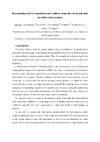Please use this identifier to cite or link to this item:
https://accedacris.ulpgc.es/jspui/handle/10553/45574
| Title: | Determination of level populations and radiative properties of optically thin and thick carbon plasmas | Authors: | Gil, J. M. Rodríguez, R. Florido, R. Rubiano, J. G. Martel, P. Mendoza, M. Suárez, D. Mínguez, E. |
UNESCO Clasification: | 22 Física 220715 Energía nuclear |
Keywords: | Carbon plasmas | Issue Date: | 2008 | Project: | Desarrollo de Un Codigo de Dagnosis de Plasmas Ultradensos y Calientes Empleando Potenciales Atomicos Analiticos y Potenciales Con Correlacion Ion-Ion. | Conference: | 35th European Physical Society Conference on Plasma Physics, EPS 2008 Combined with the 10th International Workshop on Fast Ignition of Fusion Targets | Abstract: | In several research fields of current interest such as astrophysics or inertial fusion confinement the knowledge of the interactions between the photons and the plasma particles, i.e. plasma radiative properties, result essential. Thus, for example, the understanding of these plasmas requires properties such as emissivities and opacities both for hydro-simulations and diagnostics. Carbon is one of the most interesting elements under investigation, since it is likely to be a major plasma-facing wall component in ITER, and it plays a major role in inertial fusion scenarios. Also, some laser experiments have focused on the spectrally resolved emission from hydrocarbon systems. Therefore, radiative properties from carbon plasmas must be known and, as a consequence, the theoretical study of these plasmas is a subject of current interest and many efforts are headed. In particular, recent NLTE workshops have focused on comparisons of modelling calculations for specific cases that allow testing the models since there are very few experimental measurements for carbon plasmas. For these reasons it is interesting to characterize them in a wide range of plasma conditions. In a previous work we carried out an exhaustive study of optically thin carbon plasmas under steady state condition in a wide range of electron densities and temperatures given by (1-200) eV and (10 12 -10 22 ) cm -3 respectively [1], where CE, NLTE or LTE regimes are achieved. In this work we analyse the reabsorption radiation effects for homogeneous carbon plasmas in planar geometry by means of the escape factor formalism. We focus our attention on the average ionization and ionic populations as well as the multifrequential and mean opacity. All the calculations presented in this work were performed by using ABAKO code [1] which integrates the RAPCAL code [2] in order to calculate optical properties for a wide range of temperatures and electron number densities. | URI: | https://accedacris.ulpgc.es/handle/10553/45574 | ISBN: | 9781622763351 | Source: | 35th European Physical Society Conference Plasma Physics combined with 10th International Workshop of Fast Ignition of Fusion Targets - Europhysics Conference Abstracts, v. 32, p. 1294-1297 |
| Appears in Collections: | Actas de congresos |
Page view(s)
148
checked on May 17, 2025
Download(s)
33
checked on May 17, 2025
Google ScholarTM
Check
Altmetric
Share
Export metadata
Items in accedaCRIS are protected by copyright, with all rights reserved, unless otherwise indicated.
